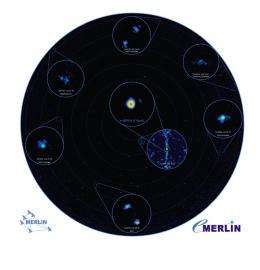e-MERLIN set to give wizard new view of Hubble Deep Field region

(PhysOrg.com) -- The Hubble Deep Field (HDF), taken by the Hubble Space Telescope in the 1990s, is one of the most iconic images in astronomy. Now, astronomers at Jodrell Bank Observatory have produced a high-resolution mosaic of the HDF region using observations from the MERLIN and VLA radio telescope arrays, as well as the new e-MERLIN array.
Nineteen separate images have been stitched together to create the widest high-resolution radio map of the region to date. The area observed measures a quarter of a degree wide, about half the apparent diameter of the full moon, and depicts numerous galaxies billions of light-years away. The map is inset with images showing even sharper views of some of the galaxies observed. The map will be presented at the RAS National Astronomy Meeting in Llandudno by graduate student, Nick Wrigley, on Wednesday 20th April.
The MERLIN array is in the final stages of an upgrade to become the e-MERLIN array of seven radio telescopes, spanning 217km, connected by a new optical fibre network and operated from Jodrell Bank by the University of Manchester. Wrigley, under the supervision of Dr. Rob Beswick and Dr. Tom Muxlow at the Jodrell Bank Centre for Astrophysics, has created the map as a pilot study for a future e-MERLIN survey, which will focus on ever deeper (more sensitive) studies in the HDF region. The survey will measure massive star formation and Active Galactic Nucleus (AGN) activity in very distant galaxies, tracing the development of the stellar populations and black hole growth in the first massive galaxies.
"This type of high-resolution imagery provided by MERLIN, and soon e-MERLIN, will allow astronomers to distinguish between different types of galaxies mapped, with the wide field of view allowing relative populations to be determined, giving insights into how they change over cosmological time. In the centre of the image is a galaxy with a bright AGN, a feature thought to be caused by matter falling towards a central super-massive black hole. This close-up is the most recent image taken by e-MERLIN and shows the compact core in extraordinary detail," said Wrigley.
"Through e-MERLIN, we will get our first truly reliable view of the distribution of star formation within typical galaxies at the time when the bulk of the stars in the present-day Universe were being formed. e-MERLIN will help us disentangle the mystery of why we see apparently simultaneous growth of the black holes and stellar populations in galaxies," added Muxlow.
"Using the more accurate observations from e-MERLIN, it will be possible to produce more precise models of the physical process of star formation and understand how star clusters affect the growth of stellar populations, providing answers to some key questions in modern cosmology."
Provided by Royal Astronomical Society

















